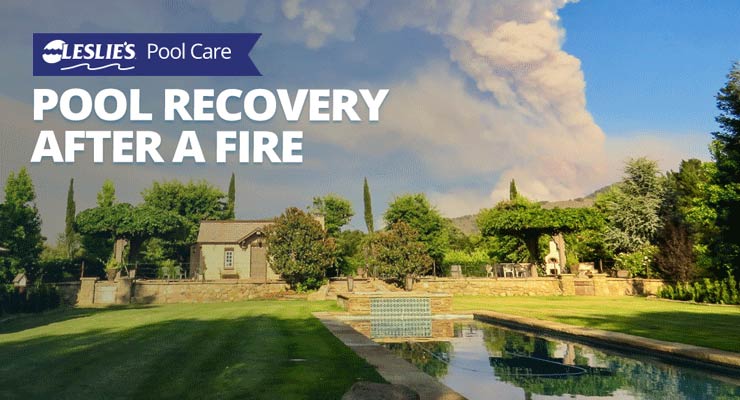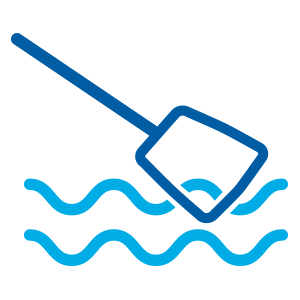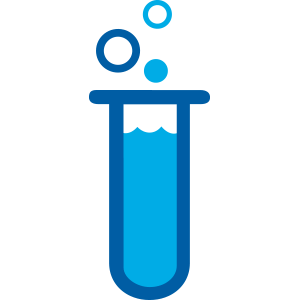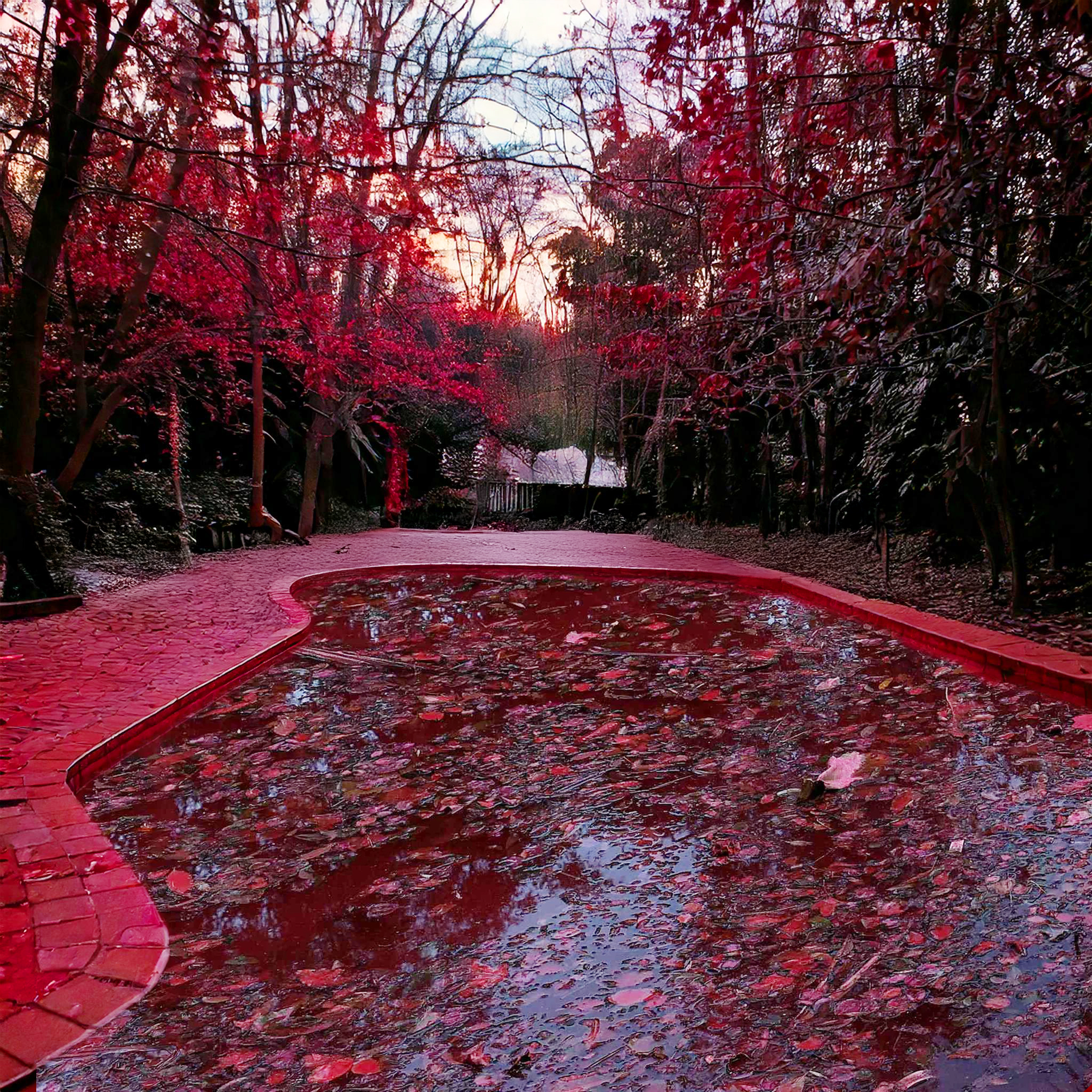
Pool Recovery After a Fire: How to Clean Soot and Ash from Your Pool
Wildfires are devastating events, especially when they impact homes and surrounding areas. Fires are an unthinkable disaster, and impact or cause damage to thousands of homes every year — including many with swimming pools. Much like other natural disasters, wildfires can cause significant problems for you and your pool. Even if your home and pool is out of real danger from a fire, there's a good chance that soot, ash, fire retardant, and related debris will still make its way into the pool. We know it’s not always the first priority for a homeowner after a natural disaster, but we recommend cleaning your swimming pool as soon as possible to avoid serious and lasting damage.
To quickly recover your swimming pool from the impacts of a fire, we recommend that you:

Clean debris from the water surface and pool floor.

Make sure your filtration system is functioning properly.

Check your water level and adjust accordingly.

Check and adjust your pH and chlorine levels.

If you don't have electrical power, remove as much debris as possible by hand.
Skim Water Surface for Ash and Debris
It is important to remove larger debris from the water surface before turning on your filtration system. This will make the next few steps a lot easier. Begin cleaning your pool by removing as much of the soot, ash, and debris as possible from the water surface, using a telepole or skimmer net.
BONUS TIP: Cover the net with an old T-shirt or another type of cloth to trap fine particles, as the mesh on the net is generally too large to capture this type of debris.
Ash and soot may cause staining on above ground pool liners, inground plaster pool surfaces, and the surrounding deck area. The quicker you can remove the ash and soot, the less of a chance for permanent staining.
Check Your Pool Pump and Clean the Filter
In many cases, the pool pump is turned off when a pool owner knows that a natural disaster is imminent. Early in the recovery process is a good time to turn on your pool pump back on and ensure that it's up and running. Before turning on the pump, check the pump strainer and skimmer baskets, and clean them often, as necessary. You should also check the pressure gauge on the filter to see whether you need to backwash or clean the filter. Check the manufacturer’s recommendation on when it's time to clean or backwash a filter — for most filters, this is when the filter gauge reads 8–10 psi higher than the starting "clean" pressure.
Keep in mind that your pool filter may quickly fill up with dirt and debris, so remember to backwash and clean the filter often during the fire recovery period. Check with your city code for proper waste space for backwash water (perhaps your lawn or gravel).
Running the filtration system is also important, because it circulates stagnant water. Running the pump and filter also helps distribute pool chemicals throughout the swimming pool as you work to rebalance and sanitize the water. Continue to run the pump and filter throughout this entire process, until the water is clear.
Brush and Vacuum the Pool
Removing debris from the bottom of a pool is vital too. Brush the walls and pool bottom to loosen debris and contaminants. Then use an automatic pool cleaner or manual vacuum to remove the debris. Start by cleaning the shallow end, and work your way through the deep end of the pool.
Check Your Water Levels
Now, let's take a look at the water level. After a fire, your water levels might be a bit off, so check to see whether you need to add more water to your pool. The water level may also drop with repeated backwashing cycles. Remember that your pool water level should be around the middle of the skimmer opening. If it's lower than that, add water to prevent damage to your pool equipment. If water levels are too high, your skimmer can't work effectively.
Check pH Levels
After checking the water level, make sure the pH level is in a healthy range. Ash and soot may alter the pH in your pool, which can impact chlorine's ability to sanitize the water. That said, it's extremely important to avoid swimming until pH is in the ideal range of 7.4–7.6 ppm, among other aspects of water chemistry. Using Soda Ash (pH increaser) or Dry Acid (pH reducer) can bring the pH level back to a balanced range. You may also need to adjust your Total Alkalinity between 80–120 ppm, depending on the type of sanitizer you use.
Check Chlorine Level
Ash and soot from a wildfire can also alter the chlorine level in your pool water. We recommend shocking the pool after balancing the water, and suggest refilling your chlorine dispenser.
BONUS TIP: Need help with your pool water? The friendly team of experts at Leslie's can help! Bring us a sample of your pool water for a FREE in-store AccuBlue® water analysis. In 60 seconds, you'll have a customized treatment plan to take home, including detailed step-by-step instructions and chemical dosages needed to rebalance and sanitize your pool water.
Remove Stains on Pool Surfaces
If you have any residue or stains remaining on pool surfaces, try adding a stain and scale remover. Pool stain removers can eliminate most stains within 2–4 weeks. The sooner you take action, the less likely you'll have to deal with permanent discoloration in your pool.
For extremely stained plaster surfaces, you may need to hire a pool maintenance professional to acid wash the pool. Leslie’s offers a Pool Acid Wash Service (in qualified areas) to take all worry and hassle out of cleaning the walls and floor of your pool.
No Electricity? Try This.
If you are without power because of the effects of the fire, we suggest removing debris manually. If you have access to tap water, use a leaf bagger with a fine mesh bag to remove small debris. Additionally, be sure to superchlorinate your water to keep your Free Available Chlorine (FAC) level between 5.0–10.0 ppm. When adding shock to the pool without the help of a pool pump to circulate the water, agitate the water with a pool brush or battery-operated pool cleaner.

Bonus: Dealing With Fire Retardant in Your Pool
Fire retardants used during wildfires often contain chemicals like ammonium phosphate, a common fertilizer, and additives like iron oxide, which can give the substance a distinctive color. These vibrant hues serve a practical purpose by helping pilots and ground crews see where the retardant has been applied. While invaluable at slowing or stopping the spread of devastating wildfires, fire retardants can introduce phosphates, nitrates, and other chemicals into pool water, which may lead to various issues.
Phosphates in fire retardants act as nutrients for algae, increasing the likelihood of algae blooms in pools. Furthermore, these chemicals can disrupt the pool’s pH balance, making the water too acidic or too basic. Such imbalances, combined with additional contaminants like soot and ash, often elevate chlorine demand, making it harder to maintain clean and safe water.
How to Clean Your Pool After Exposure to Fire Retardant
Removing the fire retardant as quickly — and safely — as possible is key to getting your pool water clean and clear. Follow these steps to properly clean your pool and balance the water:
1. Skim, brush, and vacuum the pool
Use a skimmer net, pool brush, and manual vacuum or automatic pool cleaner to remove retardant foam and residue from the pool.
2. Clean the pump strainer and skimmer baskets
Empty and clean debris, retardant, and other contaminants out of the pump strainer basket and skimmer basket to ensure optimal circulation.
3. Clean or backwash filter
Thoroughly clean or backwash your filter to eliminate any retardant residue. For cartridge filters, soak the cartridges in a cleaning solution to remove oils, debris, and lingering contaminants.
4. Run the pump and filter
Once clean, run your filter and pump continuously throughout the rest of the treatment process until the water is clear.
5. Test and balance water chemistry
Using a test kit, test strips, or electronic testing device, like Leslie’s AccuBlue Home®, test your pool’s pH, Alkalinity, Calcium Hardness, and sanitizer levels. Adjust the levels accordingly until they are within the ideal ranges. A well-balanced pool is essential for maintaining clear water and preventing further chemical issues.
6. Shock the pool
Use a powerful chlorine-based shock, like Leslie’s Power Powder Plus or Leslie’s Chlor Brite, to boost the chlorine level and break down contaminants.
7. Use an enzyme product
Finally, adding an enzyme-based product, like Leslie’s Perfect Weekly, will not only keep contaminants at bay, but also eliminate oils to help improve filter efficiency.
Natural disasters, such as wildfires, can be a scary time for any homeowner. Although we strive to keep your pool safe and healthy, we understand that you and your family’s safety always comes first. We encourage staying safe during dangerous conditions and to not worry about the cleanup until it’s safe. If you have any questions about recovering your pool after a wildfire, call or stop by your local Leslie's. You can also download our detailed fire recovery checklist.